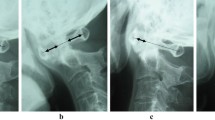Abstract
The upper cervical spine is a common focus of destruction from rheumatoid arthritis (RA). Atlanto-axial subluxation (AAS) presents with marked frequency among patients with instability. However, there are occasional patients who show no motion between the occipital bone and atlas on a dynamic cervical radiograph in AAS patients. This study investigated the morphology of the atlanto-occipital joint (AOJ) in AAS patients due to RA using computed tomography, and examined the relationship between its morphology and other radiographic results. Twenty-six consecutive patients with AAS due to RA treated by surgery were reviewed. The subjects included 18 females and 8 males. The average patient age was 59.3 years. The mean duration of RA was 14.3 years. In all the patients, the AOJ was morphologically evaluated using sagittal reconstruction view on computed tomography before surgery. Moreover, the ADI value was investigated at the neutral and maximal flexion position, and atlanto-axial angle (AAA) at the neutral position in preoperative lateral cervical radiographs. The morphology of the AOJ on a CT sagittal reconstruction view was classified into three types as follows: a normal type which showed a maintenance of the joint space, a narrow type which showed a disappearance of the joint space and a fused type which showed the fusion of the AOJ. The pre-operative CT sagittal reconstruction image of the AOJ demonstrated a normal type bilaterally in six cases (Group A). In 15 cases (Group B), CT image demonstrated narrowing on at least one side of the AOJ. In five cases (Group C), CT images demonstrated fusion on at least one side of the AOJ. The average ADI value at the flexion position was 10.7 mm in Group A, 11.7 mm in Group B, and 12.6 mm in Group C. There was no significant difference among those groups. The average ADI value at the neutral position before surgery was 2.8 mm in Group A, 5.9 mm in Group B, and 10.4 mm in Group C. There was no significant difference between Group A and B (P > 0.105), and Groups B and C (P > 0.032), however, there was a significant difference between Groups A and C (P < 0.004). The average AAA value was 25.3° in Group A, 19.3° in Group B and 3.4° in Group C. There was no significant difference between Groups A and B (P > 0.230), however, there was a significant difference between Groups A and C (P < 0.002), and Groups B and C (P < 0.007). This study showed that fusion or ankylosis of the AOJ induced an enlargement of the ADI and anterior inclination of the atlas in the neutral position, despite the fact that normal findings of AOJ showed a slight displacement of the atlas to axis in RA patients showing AAS involvement. This morphology may progress to SAS and VS due to AOJ after atlanto-axial arthrodesis.








Similar content being viewed by others
References
Casey AT, Crockard HA, Bland JM (1996) Surgery on the rheumatoid cervical spine for the non-ambulant myelopathic patient- too much, too late? Lancet 347:1004–1007
Eulderink F, Meijers KAE (1976) Pathology of the cervical spine in rheumatoid arthritis: a controlled study of 44 patients. J Pathol 120:91–108
Fujiya M, Oguma T, Hasegawa K et al (2003) Long-term outcome of the operated cervical spine in rheumatoid arthritis: comparative study of cases with and without vertical subluxation (in Japanese). Rinsho Seikei Geka 38:427–435
Grob D (2000) Atlantoaxial immobilization in rheumatoid arthritis: a prophylactic procedure? Eur Spine J 9:404–409
O’brien MF, Casey ATH, Crockard A, Pringle J, Stevens JM (2002) Histology of the craniocervical junction in chronic rheumatoid arthritis: A clinicopathologic analysis of 33 operative cases. Spine 27:2245–2254
Toyama Y, Matsumoto M, Chiba K et al (1992) The optimum position of fusion in atlantoaxial arthrodesis. 20th annual meeting of Cervical Spine Research Society 20:59 (Abstract)
Author information
Authors and Affiliations
Corresponding author
Additional information
No benefits in any form have been received or will be received from a commercial party related directly or indirectly to the subject of this article.
Rights and permissions
About this article
Cite this article
Iizuka, H., Sorimachi, Y., Ara, T. et al. Relationship between the morphology of the atlanto-occipital joint and the radiographic results in patients with atlanto-axial subluxation due to rheumatoid arthritis. Eur Spine J 17, 826–830 (2008). https://doi.org/10.1007/s00586-008-0659-0
Received:
Revised:
Accepted:
Published:
Issue Date:
DOI: https://doi.org/10.1007/s00586-008-0659-0




